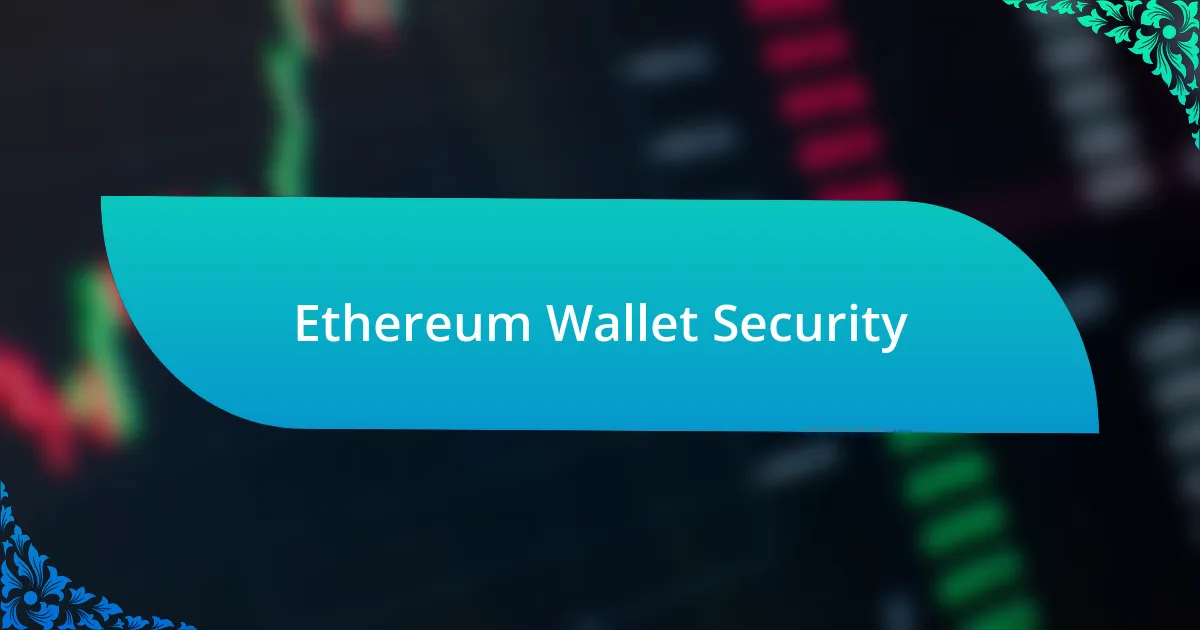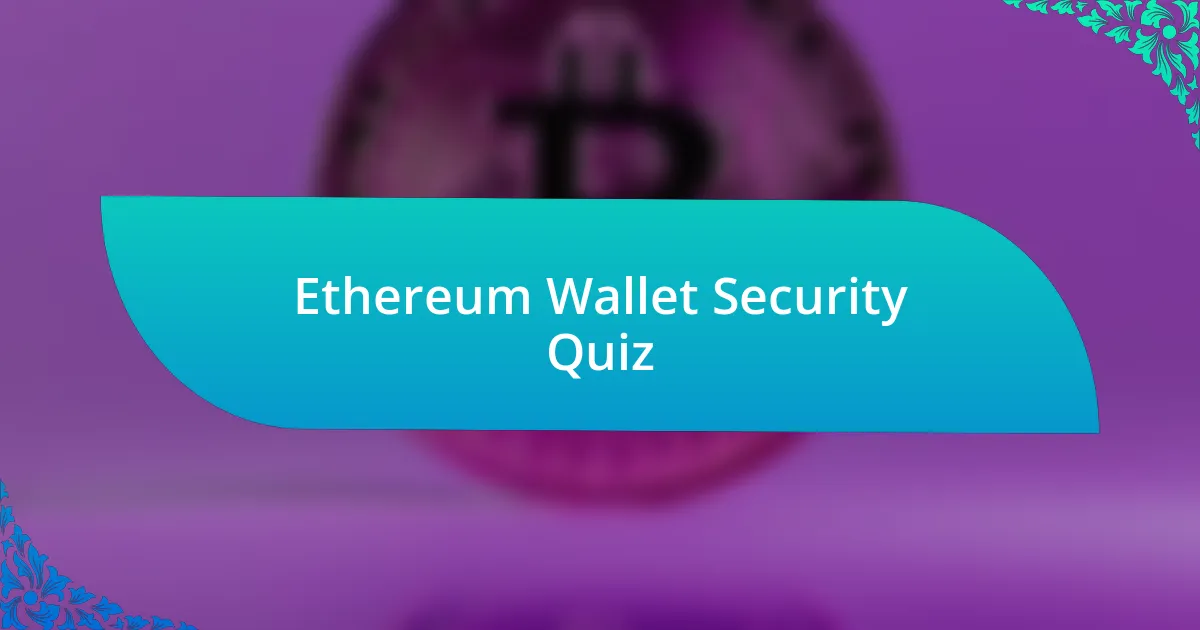
Start of Ethereum Wallet Security Quiz
1. What is the principle behind Ethereum wallet security?
- Self-custody.
- Automatic recovery.
- Password sharing.
- Centralized management.
2. Why is self-custody crucial for Ethereum wallet security?
- It protects users from unauthorized access and ensures they are responsible for securing their own wallets.
- It guarantees that wallets are always immune to attacks and hacks.
- It allows users to share their keys with others for easier access.
- It enables users to store their wallets on public servers safely.
3. What should you do to protect yourself from common scams targeting Ethereum users?
- Educate yourself about potential scams and be vigilant.
- Use the same password across all platforms.
- Share your private keys with friends.
- Click on unknown links in emails.
4. How can scammers manipulate the setApprovalForAll function?
- Scammers can alter contract codes to make your tokens disappear.
- Scammers can use this function to double-spend your tokens on the blockchain.
- Scammers can lock your wallet and demand a ransom for access.
- Scammers can manipulate this function to gain access to your Non-Fungible Tokens (NFTs) without your explicit approval.
5. What is the purpose of enabling Two-Factor Authentication (2FA) in Ethereum wallets?
- To add an extra layer of security against unauthorized access.
- To share access with multiple users.
- To speed up transaction processing times.
- To reduce gas fees for transactions.
6. Why is it important to regularly update your Ethereum wallet software?
- To implement the latest security patches and enhancements that address vulnerabilities.
- To change the wallet interface for better user experience.
- To access advanced trading features not available before.
- To improve transaction speeds and reduce fees.
7. What is the advantage of using a hardware wallet for Ethereum wallet security?
- It stores private keys offline, protecting them from online hacks.
- It allows for unlimited transactions without fees.
- It connects directly to the internet for easy access.
- It offers rewards for holding assets like a savings account.
8. How can you mitigate the risks associated with setApprovalForAll requests?
- Disable all security features to make transactions faster.
- Share your private key for easy access to approvals.
- Verify transaction details and thoroughly review contract permissions before approving any setApprovalForAll requests.
- Approve all requests without checking permissions to save time.
9. What should you do if you suspect a phishing attack on your Ethereum wallet?
- Double-check URLs, use trusted sources for downloading wallet software, and refrain from sharing private keys or seed phrases with anyone.
- Disable all security features in the wallet settings.
- Ignore the warning and continue using the wallet.
- Share your private keys with support staff to resolve the issue.
10. Why is it crucial to back up your Ethereum wallet?
- To guarantee that all your NFTs remain permanently locked in the wallet.
- To ensure faster transaction processing times during network congestion.
- To allow automatic updates without requiring user intervention.
- To protect against data loss in case of a lost device or forgotten password.
11. What is the significance of verifying transaction details in Ethereum wallets?
- To increase the transaction fees automatically.
- To verify the identity of the wallet owner.
- To ensure that transactions are legitimate and not part of a scam.
- To speed up the transaction process.
12. How can you ensure the security of your Ethereum wallet?
- Only relying on a strong password for protection.
- Keeping your private keys written down on paper.
- By using a strong password, enabling 2FA, and regularly updating your wallet software.
- Ignoring wallet software updates completely.
13. What is the role of recovery seed phrases in Ethereum wallet security?
- Recovery seed phrases are used to recover your wallet in case you lose access to it.
- Recovery seed phrases are meant to store your private keys securely in the cloud.
- Recovery seed phrases are used to enhance transaction speed in the blockchain.
- Recovery seed phrases help secure NFTs from unauthorized transactions.
14. Why is it important to use trusted platforms for trading Ethereum?
- To enhance the visibility of your trading history.
- To increase transaction fees during trading activities.
- To reduce the risk of encountering security incidents and scams.
- To gain access to more cryptocurrency options.
15. What is the difference between a mobile wallet and a hardware wallet?
- A mobile wallet stores private keys on your device, while a hardware wallet stores them offline.
- A mobile wallet uses paper receipts, while a hardware wallet uses cloud storage.
- A mobile wallet only works with mobile apps, whereas a hardware wallet works on computers.
- A mobile wallet is slower than a hardware wallet in processing transactions.
16. How can you protect your private keys from unauthorized access?
- Share them with friends for convenience.
- Write them down in a text file on your computer.
- Keep them offline and avoid sharing them with anyone or any untrusted platforms.
- Store them on a public cloud service for easy access.
17. What is the purpose of multi-signature support in Ethereum wallets?
- To reduce the transaction fees for all users.
- To add an extra layer of security by requiring multiple approvals for transactions.
- To automatically convert cryptocurrencies to fiat currencies.
- To speed up transaction processing times significantly.
18. Why is it essential to monitor your account activity regularly?
- To increase the number of transactions you can perform.
- To improve your transaction speeds dramatically.
- To detect any suspicious transactions or unexpected changes in NFT ownership.
- To maximize your Ethereum wallet balance efficiently.
19. What is the significance of encryption in Ethereum wallet security?
- To simplify user interface designs.
- To protect sensitive data from unauthorized access.
- To increase the value of Ethereum assets.
- To speed up transaction processing times.
20. How can you prevent clipboard hijacking in Ethereum wallets?
- By avoiding all online transactions altogether.
- By disabling all security features on your wallet.
- By implementing clipboard monitoring to detect unauthorized changes.
- By sharing your passwords with trusted contacts.
21. What is the role of oracles in Ethereum smart contracts?
- Oracles verify user identities before transactions occur.
- Oracles provide external data to smart contracts, ensuring they have the necessary information to execute transactions correctly.
- Oracles mine Ethereum blocks for faster transactions.
- Oracles store all blockchain data permanently for security.
22. Why is it recommended to wait for multiple confirmations before considering a transaction irreversible?
- To increase the transaction fee paid to miners for processing.
- To ensure the transaction is secure and cannot be reversed.
- To modify the details of the transaction after it has been submitted.
- To improve the speed at which the transaction is processed on the blockchain.
23. What is the difference between a custodial and non-custodial Ethereum wallet?
- A custodial wallet stores your funds on a bank while a non-custodial wallet does not.
- A custodial wallet requires monthly fees while a non-custodial wallet is always free.
- A custodial wallet has a third party managing your private keys, while a non-custodial wallet gives you complete control over your private keys.
- A custodial wallet can only be accessed through a mobile app, while a non-custodial wallet is desktop-only.
24. How can you ensure the integrity of your Ethereum wallet setup?
- By sharing your wallet information with as many people as possible.
- By using a weak password that is easy to remember.
- By verifying the wallet functions correctly and ensuring you can lock and unlock it.
- By disabling Two-Factor Authentication to simplify access.
25. What is the purpose of session timeouts in Ethereum wallet security?
- To automatically back up user data to the cloud.
- To increase the speed of the wallet application.
- To temporarily disable all transactions until user verification.
- To log out users after a period of inactivity, preventing unauthorized access.
26. Why is it important to use a secure password for your Ethereum wallet?
- To make transactions faster and easier.
- To prevent unauthorized access to your wallet and its contents.
- To automatically earn interest on your funds.
- To increase the amount of Ethereum you can send.
27. What is the significance of sandboxing techniques in Ethereum wallet security?
- To isolate wallet functions from other applications, preventing malware from compromising the wallet.
- To allow easier access to multiple user accounts simultaneously.
- To enhance transaction speed and efficiency within the blockchain.
- To facilitate the exchange of cryptocurrencies without fees.
28. How can you protect your Ethereum wallet from malware?
- By connecting your wallet to public Wi-Fi networks frequently.
- By sharing your private keys with trusted friends.
- By downloading random apps that promise better security.
- By adhering to platform security standards and using anti-malware measures.
29. What is the purpose of anti-malware measures in Ethereum wallet security?
- To detect and prevent malware from compromising sensitive wallet data.
- To enhance transaction speeds and ensure faster confirmations.
- To provide a backup solution for lost wallet access.
- To increase the mining power of Ethereum nodes for better performance.
30. Why is it crucial to keep your Ethereum wallet software up to date?
- To ensure the wallet can connect to more networks and tokens.
- To update the user interface and improve aesthetics.
- To receive the latest security patches and enhancements that address vulnerabilities.
- To automatically back up all transaction history in the cloud.

Quiz Successfully Completed!
Congratulations on completing our quiz on Ethereum Wallet Security! You have taken an important step toward understanding the critical aspects of securing your digital assets. Throughout the quiz, you explored various topics, from types of wallets to best practices for safeguarding your cryptocurrencies. This knowledge is essential for anyone looking to navigate the world of Ethereum safely.
Many key points may have stood out to you. For instance, you learned about the differences between hot and cold wallets. You also discovered the importance of two-factor authentication and regular software updates. These concepts are vital for protecting your assets against potential threats in the digital environment.
To further enhance your understanding, we invite you to check out the next section on this page. It contains detailed information about Ethereum Wallet Security. Dive deeper into encryption methods, common pitfalls, and innovative security practices. Expanding your knowledge on these topics will empower you to manage your Ethereum assets more confidently and securely.

Ethereum Wallet Security
Understanding Ethereum Wallets
Ethereum wallets are digital tools that allow users to store, send, and receive Ether and other tokens on the Ethereum blockchain. They can be software-based, like mobile or desktop applications, or hardware wallets, which are physical devices. Each wallet has a unique address and generates keys to access the funds securely. The security of these wallets is vital, as they are primary targets for hackers.
Types of Ethereum Wallets
There are several types of Ethereum wallets, including hot wallets and cold wallets. Hot wallets connect to the internet and provide easy access but are more vulnerable to attacks. Cold wallets, like hardware wallets or paper wallets, are not connected to the internet and offer higher security but less convenience. Choosing the right type impacts wallet security significantly.
Common Security Risks for Ethereum Wallets
Security risks for Ethereum wallets include phishing attacks, malware, and hacking of hot wallets. Phishing involves tricking users into providing their private keys or seed phrases through fake websites or emails. Malware can compromise devices, allowing attackers to gain access. Hacking can lead to the theft of funds from online wallets due to inadequate security measures.
Best Practices for Securing Ethereum Wallets
To ensure security, users should use strong, unique passwords and enable two-factor authentication. Regularly updating wallet software and utilizing cold storage for significant amounts of Ether is critical. Users should also be cautious of phishing attempts by verifying URLs and avoiding unknown links that could compromise their wallet credentials.
Recovery and Backup Strategies for Ethereum Wallets
Backing up the wallet is essential for preventing loss of access to funds. Users should securely store seed phrases and private keys in multiple locations. Utilizing hardware wallets makes recovery easier since they often provide recovery options. Proper recovery strategies ensure that users can regain access even if their device is lost or damaged.
What is an Ethereum wallet?
An Ethereum wallet is a digital tool that allows users to store, send, and receive Ether and other Ethereum-based tokens. It can be software-based, like mobile or desktop apps, or hardware-based, which are physical devices. Ethereum wallets manage the user’s private and public keys, enabling secure transactions on the Ethereum blockchain.
How can I secure my Ethereum wallet?
To secure your Ethereum wallet, use hardware wallets for offline storage, enable two-factor authentication (2FA), and create strong passwords. Regularly update your wallet software and back up your wallet data. Avoid sharing sensitive information and be wary of phishing attacks, as these can compromise your wallet’s security.
Where should I store my Ethereum wallet backup?
You should store your Ethereum wallet backup in a safe and secure location, away from potential hazards like fire or water damage. A secure physical location could be a safe or safety deposit box. For digital backups, consider using encrypted cloud storage or secure USB drives, ensuring that access is limited to trusted individuals.
When should I update my Ethereum wallet software?
You should update your Ethereum wallet software as soon as a new version is released. Updates often include security patches, bug fixes, and enhancements that protect against vulnerabilities. Keeping your wallet software current is crucial for maintaining optimal security and access to the latest features.
Who is responsible for the security of my Ethereum wallet?
You are responsible for the security of your Ethereum wallet. Unlike traditional banks, cryptocurrencies do not have intermediary authorities that provide protection. It is essential to implement security measures, follow best practices, and be aware of potential threats to safeguard your assets.

